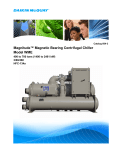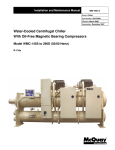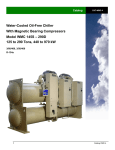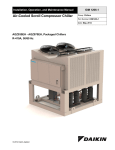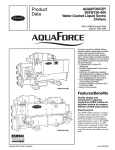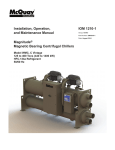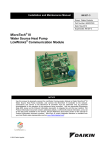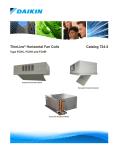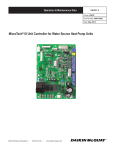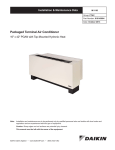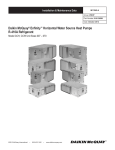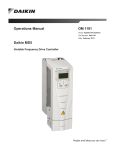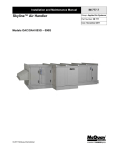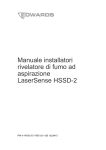Download Daikin WMC Specifications
Transcript
Magnitude® Magnetic Bearing Centrifugal Chillers Model WMC C Vintage 145 to 400 Tons (500 to 1400 kW) HFC-134a Refrigerant Catalog 602-4 Table of Contents Table of Contents Introduction . . . . . . . . . . . . . . . . . . . . . . . . . . . . . . . . . 3 Refrigeration Diagram . . . . . . . . . . . . . . . . . . . . . . . . 12 Technology That Just Makes Sense . . . . . . . . . . . . . 3 Application Considerations . . . . . . . . . . . . . . . . . . . 13 Features and Benefits Summary . . . . . . . . . . . . . . . . 3 Location Requirements . . . . . . . . . . . . . . . . . . . . . . 13 Features and Benefits . . . . . . . . . . . . . . . . . . . . . . . . . 4 System Requirements . . . . . . . . . . . . . . . . . . . . . . . 13 The Compressor Technology . . . . . . . . . . . . . . . . . . . 4 Optimizing Efficiency . . . . . . . . . . . . . . . . . . . . . . . . 13 Integrated Variable Frequency Drive . . . . . . . . . . . . . 5 Evaporator . . . . . . . . . . . . . . . . . . . . . . . . . . . . . . . . 13 The Control Technology . . . . . . . . . . . . . . . . . . . . . . . 5 Condenser . . . . . . . . . . . . . . . . . . . . . . . . . . . . . . . . 14 Certifications and Standards . . . . . . . . . . . . . . . . . . . 6 Retrofit Knockdown . . . . . . . . . . . . . . . . . . . . . . . . . 15 Factory Testing . . . . . . . . . . . . . . . . . . . . . . . . . . . . . 7 Engineering Guide Specifications . . . . . . . . . . . . . . 17 Dimensions . . . . . . . . . . . . . . . . . . . . . . . . . . . . . . . . . 8 Unit Dimensions . . . . . . . . . . . . . . . . . . . . . . . . . . . . . 8 Drawing Notes . . . . . . . . . . . . . . . . . . . . . . . . . . . . . . 9 Options and Accessories . . . . . . . . . . . . . . . . . . . . . 10 Unit Options . . . . . . . . . . . . . . . . . . . . . . . . . . . . . . . 10 Vessel Options . . . . . . . . . . . . . . . . . . . . . . . . . . . . . 10 Controls Options . . . . . . . . . . . . . . . . . . . . . . . . . . . 10 Electrical Options . . . . . . . . . . . . . . . . . . . . . . . . . . . 10 Special Order Options . . . . . . . . . . . . . . . . . . . . . . . . 11 Manufactured in an ISO-certified facility ©2014 Daikin Applied. Illustrations and data cover the Daikin Applied product at the time of publication and we reserve the right to make changes in design and construction at anytime without notice. CAT 602-4 • MAGNITUDE® MODEL WMC CHILLERS 2 www.DaikinApplied.com Introduction Introduction Magnitude® Magnetic Bearing Chillers WME0700S WME0500S WMC400D WMC290D Model WME 500 - 700 WMC250D WMC150D WMC145D WMC145S 100 200 Model WMC 145 - 400 300 400 500 600 700 Technology That Just Makes Sense Features and Benefits Summary The industry’s next generation of centrifugal chillers is here today with Daikin Magnitude® chillers. The new technology begins with centrifugal compressors utilizing magnetic bearings for oil-free operation, integral variable-frequency drives, and direct drive technology. The high efficiency compressor is matched with highly efficient heat exchanges to make an impressive chiller. Magnitude® chillers have many important features: The Compressor Technology 800 • Magnetic bearing system that results in greater efficiency and reliability, more sustainable performance, reduced operating and maintenance costs, and low vibration and sound levels compared to traditional oil centrifugals. Integrated Variable Frequency Drive • State-of-the-art magnetic bearing compressor with oil-free technology • Unit-mounted Variable Frequency Drive • Positive pressure design • Hermetic, permanent magnet, direct-drive motor • User-friendly MicroTech® controls • Open Choices™ feature for BAS of your choice • Unit-mounted VFD modulates compressor speed to obtain optimum efficiency at all load and lift conditions. The Control Technology • Onboard digital electronics provide smart controls and includes a regenerative power system, user-friendly operator interface, RapidRestore® option, and Open Choices™ BAS flexibility. Certifications and Standards • R-134a refrigerant • Meets ASHRAE Std. 90.1, AHRI 550/590 and IBC/ (Zero ozone depletion and no refrigerant phase out) OSHPD Seismic, and contributes to LEED ® credits. • AHRI certification Factory Testing • Ensures trouble free startup and reliable operation. www.DaikinApplied.com 3 CAT 602-4 • MAGNITUDE® MODEL WMC CHILLERS Features and Benefits Features and Benefits The Compressor Technology Model WMC’s exceptional efficiency and reliability is due to its cutting-edge magnetic bearing compressor technology. A digitally-controlled magnetic bearing system replaces conventional oil lubricated bearings and a direct drive motor eliminates the need for a lubricated gear box. The compressor shaft, shown in Figure 1, levitates on a magnetic cushion and is the compressor’s only major moving component. Sensors at each magnetic bearing provide real-time feedback to the bearing control system. As a result of this sophisticated design, model WMC has many advantages over chillers with traditional centrifugal compressors. Figure 1: Magnetic Bearing Compressor 1. Magnetic Bearings and Bearing Sensors 3 1 3 2. Permanent Magnet Synchronous Motor 1 5 3. Backup Bearings 4. Shaft and Impellers 5. Compressor Cooling 2 4 Oil-Free Compressor Design Benefits No Oil Management System = Greater Reliability Totally Oil-Free Operation = Greater Efficiency With magnetic bearings operating in a magnetic field instead of oil-lubricated bearings, the oil handling equipment is removed. No need for: The use of oil-free magnetic bearing technology significantly increases chiller efficiency by reducing frictional losses within the bearing system. oil pumps oil reservoirs In addition, efficiency improvements can be realized since there is no oil to coat the heat transfer surfaces. oil coolers No Oil Loss = Sustainable Performance oil filters water regulating valves oil relief valves With no possibility of oil loss at light loads or due to worn seals, the original energy saving efficiency can be maintained for the life of the chiller. oil storage and disposal oil system controls, starter, piping, heaters, etc. that are needed to maintain oil quality. These devices can be a fault source in traditional chillers, and removing them significantly increases unit and system reliability. No Oil System = Low Vibration & Sound Levels With the use of magnetic bearings, the compressor vibration levels are extremely low, minimizing vibration that could be transmitted to the structure. With low vibration levels, sound levels are lower compared to traditional centrifugal chillers. No Oil System = Reduced Maintenance Costs With oil removed from the system, oil samples, oil changes, oil system maintenance, oil filter changes, and leaks are eliminated. CAT 602-4 • MAGNITUDE® MODEL WMC CHILLERS 4 www.DaikinApplied.com Features and Benefits The Control Technology Additional Compressor Design Benefits Model WMC’s magnetic bearing compressor design offers many benefits not only because of its oil free design but also because of its use of a positive pressure refrigerant and a variable frequency drive. It is only fitting that this revolutionary chiller design be matched with the advanced control technology to give you the ultimate chiller performance. Our control design includes many unique energy-saving features and interface enhancements. Environmentally Friendly Over time negative pressure chillers (such as those using HCFC-123) may draw air and moisture into the system, which can significantly increase energy consumption. Since the Magnitude® WMC chiller uses a positive pressure refrigerant (HFC-134a), the industry-leading efficiency can be maintained for the life of the chiller. In addition, HFC-134a has no ozone depletion potential and no phase-out schedule per the Montreal protocol unlike HCFC type refrigerants used in low pressure designs. Low Operating Costs Model WMC offers world class part load efficiency due to its magnetic compressor design, which utilizes a variable frequency drive. As a result, industry leading Integrated Part Load Value (IPLV) ratings can be achieved. This allows for significant energy savings at off-design conditions compared to fixed-speed chillers. See AHRI Certification on page 6 for more information on IPLV ratings. MicroTech® II Controller The model WMC chiller utilizes MicroTech® II digital control electronics to proactively manage unit operation and provide control of external chilled water and cooling tower pumps. The compressor runs at the minimum speed necessary to maintain cooling capacity and lift (which decreases with lower condenser water temperatures), thus minimizing energy usage over the entire range of operating conditions. By constantly monitoring chiller status and real time data, the MicroTech® II controller will automatically take proactive measures to relieve abnormal conditions or shut the unit down if a fault occurs. Additional smart features that optimize operating efficiency have been incorporated into our MicroTech® II controls: • Cooling tower control including on/off, staging, and VFD • Direct control of water pumps • Chilled water rest • Demand limit control • Ability to stage up to four WMC chillers Integrated Variable Frequency Drive A Variable Frequency Drive (VFD) modulates compressor speed in response to load and evaporator/condenser pressure. When minimum speed is reached, moveable inlet guide vanes redirect the gas flow into the impeller. VFD’s have the following benefits: • Reduced annual energy costs when there are long periods of part load operation and/or low compressor lift (lower condenser water temperature) Operator Interface Operation simplicity was one of the main considerations in the development of the MicroTech® II control system. The operator interface is a 15-inch, color touch-screen monitor that is mounted on an adjustable arm. Key operating parameters and setpoints are easily accessible. For added convenience, the unit Operating and Maintenance Manual is also viewable on the touch-screen panel. In order to track chiller performance, the MicroTech® II controller can record and plot water temperatures, refrigerant pressures, and motor load. These values can be downloaded through a convenient USB port in the interface and exported into a spreadsheet for further evaluation and record purposes. The trend history screen is shown in Figure 2. • Reduced motor starting inrush current • Reduced size of backup generators used to provide emergency power to chillers used on mission critical applications • Increased power factor to reduce utility surcharges WMC Reduced Harmonic Option The Institute of Electrical and Electronics Engineers (IEEE) has developed a standard (IEEE519) that defines acceptable limits of site specific system current and voltage distortion. The designer may wish to consult this standard to ensure acceptable levels of harmonic distortion are maintained. The standard VFD includes 3% line reactors, which dramatically reduce the harmonic distortion. An optional unitmounted harmonic filter is available for all models to meet lower harmonic level requirements. www.DaikinApplied.com 5 CAT 602-4 • MAGNITUDE® MODEL WMC CHILLERS Features and Benefits Figure 2: Operator Interface Trend History Screen Open Choices™ BAS Flexibility The exclusive Open Choices™ feature provides seamless integration and comprehensive monitoring, control, and two-way data exchange using industry standard protocols LonTalk®, BACnet ® or Modbus®. Open Choices™ offers simple and inexpensive flexibility to use the Building Automation System (BAS) of your choice without an expensive gateway panel. Open Choices™ benefits include: • Easy to integrate into your BAS of choice • Factory- or field-installed communications module • Integrated control logic for factory options • Easy-to-use local user interface • Comprehensive data exchange Certifications and Standards The controller memory (no batteries required) also retains the fault history for troubleshooting and monitoring unit performance. A time/date stamp is associated with each fault. The fault history can be downloaded through the USB port. RapidRestore® Mission critical facilities such as data centers and hospitals are demanding stringent capabilities for chillers to restart and reach full load operation quickly in the event of a power loss. With the capability of RapidRestore ®, Magnitude® model WMC chillers are engineered to meet those needs. See Table 1 below for specifications. As with many other Daikin Applied chiller products, the Magnitude® model WMC meets all necessary certifications and standards. AHRI Certification Part load performance can be presented in terms of Integrated Part Load Value (IPLV), which is defined by AHRI Standard 550/590. Based on AHRI Standard 550/590, and as shown in Figure 3, a typical chiller can operate up to 99% of the time at off-peak conditions and usually spends most of this time at less than 60% of design capacity. Figure 3: IPLV Defined by AHRI Standard 550/590 RapidRestore ® – Quickly restores cooling capacity when power is restored after a power failure • Fast Loading – Amount of time required for the chiller to reach a certain load condition Table 1: WMC RapidRestore® Times- After Power Restoration * Compressor Start Fast Loading to 80% Load 43 sec 120 sec* Estimated load time. Times may vary depending on operating conditions. CAT 602-4 • MAGNITUDE® MODEL WMC CHILLERS Percent Ton-Hour Weighting • Compressor Start – Amount of time required for the chiller to restart 50 40 42 Percent 45 Percent 30 20 10 12 Percent 1 Percent 0 100 75 50 25 Percent Load WMC chillers are rated and certified to AHRI Standard 550/590. The ability of the WMC chillers to achieve very high part load efficiencies, as evidenced by their world-class IPLV ratings, is due primarily to the use of a variable frequency drive and the low friction of the magnetic bearing system. For more information on variable frequency drives, see Integrated Variable Frequency Drive on page 5. 6 www.DaikinApplied.com Features and Benefits Compliance with ASHRAE Std. 90.1 ASHRAE Standard 90.1 was developed to assist owners and designers make informed choices on a building’s design, systems, and equipment selection. Model WMC can significantly exceed ASHRAE 90.1 minimum efficiency requirements. IBC/OSHPD Seismic Certification Daikin Magnitude® WMC chillers have been tested and certified by an independent agency, experts in seismic analysis and design to meet IBC seismic and OSHPD preapproval. Find more information about seismic requirements and HVAC systems at www.DaikinApplied.com. LEED® For building owners who wish to pursue Leadership in Energy and Environmental Design (LEED ®) Green Building Certification, the performance of the WMC may contribute points towards Energy and Atmosphere (EA) Credits 1 and 4. Points earned for EA Credit 1 are awarded based on overall building efficiency. The high efficiency of the WMC will contribute to the total points earned for this credit. EA Credit 4 qualification is partially determined by tonnage and refrigerant quantity. Vessel stack and tube count selections will affect the quantity of refrigerant in the chiller. Most WMC models qualify for the EA Credit 4. Consult with your Daikin Applied sales representative for more information. Factory Testing All Daikin Applied centrifugal chillers (50 or 60 hertz) are factory-tested prior to shipment. Operating and safety controls are checked for correct settings and operation. This testing helps reduce field start-up issues and maintain critical construction schedules. www.DaikinApplied.com 7 CAT 602-4 • MAGNITUDE® MODEL WMC CHILLERS Dimensions Dimensions Unit Dimensions Figure 4: WMC145S (2-pass, right-hand configuration, with grooved connections) L W H Figure 5: WMC145-400D (2-pass, right-hand configuration, with grooved connections) W L H Table 2: WMC145S and WMC145-400D Dimensions Model Heat Exchanger Length in (mm) Width in (mm) Height in (mm) WMC145S E2209 / C2009 134.3 (3411) 43.5 (1105) 81.0 (2057) WMC145D E2212 / C2012 134.3 (3411) 43.5 (1105) 80.8 (2052) WMC150D E2212 / C2012 169.2 (4298) 43.5 (1105) 80.8 (2052) WMC250D E2609 / C2209 134.2 (3409) 47.2 (1199) 83.8 (2129) WMC290D E2612 / C2212 169.1 (4295) 47.2 (1199) 83.9 (2131) WMC400D E3012 / C2612 168.5 (4280) 55.2 (1402) 94.3 (2395) CAT 602-4 • MAGNITUDE® MODEL WMC CHILLERS 8 www.DaikinApplied.com Dimensions Drawing Notes 1. Final connections must allow for 0.5 inch +/- (12.7mm) manufacturing tolerances. 7. All water connections are given in standard U.S. pipe sizes. Standard connections are suitable for welding or grooved couplings. 2. 1.00-inch FPT (25.4 mm) evaporator and condenser relief valves must be piped per ANSI / ASHRAE 15. Number of relief valves is 1 per evaporator and 2 per condenser. 8. Unit shown has standard right-hand water connections. Left-hand connections are available for either vessel. For right hand evaporator the inlet and outlet nozzles are reversed. ANSI-flanged connections are available upon request. When using ANSI-flanged connections add 0.5 inch (13 mm) to each flanged end. 3. 0.375 inch (9 mm) suction nozzle relief valve must be piped per ANSI / ASHRAE 15. 4. Minimum Clearances (See Figure 6): 9. Dimensions shown are for units (evaporator / condenser) with standard design pressures. The waterside design pressure is 150 psi (1034 kPa). Consult the factory for unit dimensions with higher design pressures. • Installation layout should be designed by qualified personnel familiar with local codes. • Allow a minimum of 3 ft. on all for sides and the top sides of chiller to allow for service access. • Provide a minimum of 3 ft. clearance in front of chiller starter panel or according to NEC or local codes. 10. The unit vibration isolator pads are provided for field installation and when fully loaded are 0.25 inches (6 mm) thick. • Provide a minimum of 12 ft. clearance on one end of chiller models WMC145S, 145D, and 250D for tube removal. 11. These values are for units with standard wall thickness copper tubing only. 12. The shipping skid adds 4.00 inches (105 mm) to the overall unit height. • Provide a minimum of 15 ft clearance on one end of chiller models WMC150D, 290D, and 400D for tube removal. 13. If main power wiring is brought up through the floor, this wiring must be outside the envelope of the unit. 5. Electric Panels- Most codes require 48 inches (1219 mm) clearance in front of control boxes and electrical panels. Check codes for your location. 14. The unit is shipped with an operating charge of refrigerant. 6. 3.25-inch (83 mm) diameter lifting holes are provided. See installation manual (available at www.DaikinApplied. com) for lifting instructions. 15. Optional marine water box connections are available upon request. Figure 6: Minimum Clearances Based on Standard Waterboxes Minimum 3’ Clearance on all sides and top of chiller; Minimum 12’ or 15’ Clearance (depending on model) on one side for tube removal. TOP VIEW Minimum 3’ Clearance Minimum 12’ Clearance for Tube Removal (Models WMC145S, 145D, 250D) Minimum 15’ Clearance for Tube Removal (Models WMC150D, 290D, 400D) Minimum 3’ Clearance Minimum 3’ Clearance NOTE: Hinged type waterboxes may require more clearance. Consult your Daikin Applied sales representative for details. www.DaikinApplied.com 9 CAT 602-4 • MAGNITUDE® MODEL WMC CHILLERS Options and Accessories Options and Accessories Unit Options Export Packaging A wooden skid that aids in moving the unit and tight fitting plastic covering the entire unit to protect it from dirt and grime during transit and storage are standard. Open and closed crating is also offered as an option. Pumpout Unit, With or Without Storage Vessel Available in a variety of sizes, single-phase or three-phase, with and without tanks. Contact your Daikin Applied sales office for details. Extended Warranties Extended 1, 2, 3, or 4 year warranties for parts only or for parts and labor are available for the compressor/motor only, the entire unit, or the entire unit including refrigerant. Witness Performance Test The specified full and/or part load tests, as ordered, are performed in the presence of the customer under the supervision of a factory engineer and include compilation of the test data onto an easy-to-read spreadsheet. Non-Witness Test The specified full and/or part load run tests, as ordered, are performed under the supervision of a factory engineer; data is compiled, certified and transmitted to the customer. Refrigerant Charge Holding charge of Nitrogen or R-134a. Shipping with a full charge of R-134a is standard. Knockdown Shipment Several options for a knockdown shipment to facilitate unit placement. See Retrofit Knockdown on page 15 for details. Vessel Options Marine Waterboxes Single Insulation - Evaporator Shell / Suction Piping 0.75-inch thermal insulation on cold surfaces excluding heads and waterboxes. Single Insulation - Evaporator Heads and Waterboxes 0.75-inch thermal insulation. Double Insulation - Evaporator Shell / Suction Piping 1.5-inch thermal insulation on cold surfaces (0.75-inch on suction piping) excluding heads and waterboxes. Double Insulation - Evaporator Heads and Waterboxes 1.5-inch thermal insulation. Hinged Waterbox Covers and Heads Hinges for marine waterbox covers or heads (compact waterboxes) to aid in heat exchanger maintenance. Tube Size, Wall Thickness and Material A wide range of tube options are available to accommodate most flow rates and fluids. Standard wall thickness is 0.025inch, optional 0.028-inch or 0.035-inch. Controls Options BAS Interface Module Factory-installed on the unit controller for the applicable protocol being used (Can also be retrofit): • BACnet ® MS/TP • BACnet ® IP • BACnet ® Ethernet • LonWorks® • Modbus® RTU Electrical Options Provide tube access for inspection, cleaning, and removal without dismantling water piping. Power Panel High Short Circuit Current Rating Flanges (grooved connections are standard) EMI Filter ANSI raised face flanges on either the evaporator or condenser. Mating flanges are by others. Factory-installed option. Radio interference filter. 300 psi Water Side Vessel Construction 65 kA panel rating (Standard is 35 kA). Ground Fault Protection For high pressure water systems, typically high-rise building construction (150 psi is standard). Protects equipment from arcing ground fault damage from line-to-ground fault currents less than those required for conductor protection. Epoxy and Ceramic Coating Input Power Meter Evaporator and condenser heads and marine waterboxes can be coated for corrosion protection with either epoxy or ceramic coatings. Tube sheets may also be ceramic coated. Allows display of input phase amps and volts on the operator interface screen. CAT 602-4 • MAGNITUDE® MODEL WMC CHILLERS 10www.DaikinApplied.com Options and Accessories RapidRestore® Allow chillers to restart and reach full load operation quickly in the event of a power loss event. See RapidRestore® on page 6 for more details. Special Order Options The following special order options are available; requiring factory pricing, additional engineering, and possible dimension changes or extended delivery: 1. Non-standard location of nozzle connections on heads (compact waterboxes) or marine waterboxes. 2. Special corrosion inhibiting coatings on any “wetted surface” including tubesheets, heads (compact waterboxes), marine waterboxes, or nozzles. 3. Clad tube sheets. 4. Sacrificial anodes in heads (compact waterboxes) or marine waterboxes. 5. Spacer rings on heads to accommodate automatic tube brush cleaning systems (installed by others). www.DaikinApplied.com11 CAT 602-4 • MAGNITUDE® MODEL WMC CHILLERS CAT 602-4 • MAGNITUDE® MODEL WMC CHILLERS 28 33 16 32 12 DISCHARGE HV 20 19 17 18 10 1 2 COMPRESSOR COOLING HV HV 38 PT 3 SUCTION HV 37 6 36 HV 9 SUCTION S 21 FG 30 22 STAGING 4 23 HV HV S 31 CONDENSER 13 EVAPORATOR 5 HV US05 TI TE 11 29 CFS EF CF 24 25 HV EFS 8 7 FE FI FE 14 FI IN OUT IN OUT US04 COMPRESSOR COOLING DISCHARGE MAIN LIQUID US03 TI TE TE TI 39 STAGING US02 TI TE TE TI TT US10 PT PT PT BMCC TT TT COMP TT BMCC COMP HV HV 34 27 35 26 15 PT TI TE BUTTERFLY VALVE INSULATED THREE-WAY VALVE TEMPERATURE SENSOR SPRING LOADED RELIEF VALVE UNIT CONTROL BOX BUTTERFLY VALVE BUTTERFLY VALVE PRESSURE TAP RELIEF VALVE SERVICE VALVE STAGING VALVE STAGING VALVE BALL VALVE EXPANSION VALVE BALL VALVE BALL VALVE FILTER DRYER RELIEF VALVE SIGHT GLASS PRESSURE TAP RELIEF VALVE 3-WAY VALVE RELIEF VALVE SERVICE VALVE PRESSURE TAP RELIEF VALVE FILTER DRYER BALL VALVE BALL VALVE SERVICE VALVE CHECK VALVE CHECK VALVE PRESSURE TAP PRESSURE TAP PRESSURE TAP PRESSURE TAP RELIEF VALVE RELIEF VALVE PRESSURE TAP PRESSURE TAP MANUAL MANUAL N/A MANUAL MANUAL AUTOMATIC AUTOMATIC MANUAL AUTOMATIC MANUAL MANUAL N/A MANUAL N/A N/A AUTOMATIC AUTOMATIC AUTOMATIC MANUAL N/A MANUAL N/A MANUAL MANUAL MANUAL AUTOMATIC AUTOMATIC N/A N/A N/A N/A AUTOMATIC AUTOMATIC N/A N/A N/A MANUAL AUTOMATIC MANUAL VALVE CONTROL DESCRIPTION CONDENSER FLOW SWITCH EVAPORATOR FLOW SWITCH CONDENSER FLOW SIGNAL TO CHILLER CONTROL EVAPORATOR FLOW SIGNAL TO CHILLER CONTROL CF EF CFS EFS FLOW SWITCH EVAPORATOR ENTERING WATER TEMPERATURE CONDENSER ENTERING WATER TEMPERATURE CONDENSER LEAVING WATER TEMPERATURE LIQUID LINE TEMPERATURE EVAPORATOR LEAVING WATER TEMPERATURE DESCRIPTION UNIT CONTROLLER 5 6 7 8 9 10 11 12 13 14 15 16 17 18 19 20 21 22 23 24 25 26 27 28 29 30 31 32 33 34 35 36 37 38 39 PRESSURE TAP RELIEF VALVE RELIEF VALVE SERVICE VALVE LABEL BUBBLE NO. US02 US03 US04 US05 CS10 BUBBLE NO. CF EF US10 US05 US04 US03 US02 BEARING MOTOR COMPRESSOR CONTROLER (INTERNAL TO COMPRSSOR) TEMPERATURE/PRESSURE TRANSDUCER (INTERNAL TO COMPRESSER) FLOW SWITCH FILTER DRYER ELECTRONIC EXPANSION VALVE RELIEF VALVE VENT / DRAIN CHECK VALVE (SPRING) SIGHT GLASS CENTRIFUGAL COMPRESSOR FLOW DIAGRAM, WMC 332632901 0A BMCC TT FI FE S SERVICE VALVE BALL VALVE FG FLOW CHART LEGEND 1 2 3 4 BUBBLE NO. Refrigeration Diagram Refrigeration Diagram Figure 7: Refrigeration System Diagram 12www.DaikinApplied.com Application Considerations Application Considerations Location Requirements Daikin WMC units are designed only for indoor, weatherprotected, non-freezing areas consistent with the NEMA 1 rating on the chiller, controls, and electrical panels. Equipment room temperature for operating and standby conditions is 40°F to 104°F (4.4°C to 40°C). System Requirements Piping Piping must be adequately supported to remove weight and strain on the chiller’s fittings and connections. Be sure piping is adequately insulated for job conditions. Install a cleanable 20-mesh water strainer upstream of the evaporator and condenser. Install enough shutoff valves to permit draining water from the evaporator or condenser without draining the complete system. NOTE: This product, in its standard configuration, is equipped with a shell and tube evaporator with carbon steel shell and copper tubes. The water or other fluid used in contact with the wetted surfaces of the heat exchangers must be clean and non-corrosive to the standard materials of construction. Daikin Applied makes no warranty as to the compatibility of fluids and materials. Non-compatible fluids may void the equipment warranty. If the compatibility of the fluid with the standard materials of construction is in question, a professional corrosion consultant should administer the proper testing and evaluate compatibility. Variable Fluid Flow Rates and Tube Velocities Many chiller system control and energy optimization strategies require significant changes in evaporator water flow rates. The Magnitude® chiller line is well suited to take full advantage of these energy saving opportunities using different combinations of shell sizes, number of tubes, and pass arrangements. Both excessively high and excessively low fluid flow rates should be avoided. Excessively high fluid flow rates and correspondingly high tube velocities will result in high fluid pressure drops, high pumping power, and potentially tube erosion or corrosion damage. Excessively low fluid flow rates and correspondingly low velocities should also be avoided as they will result in poor heat transfer, high compressor power, sedimentation and tube fouling. System Water Volume All chilled water systems need adequate time to recognize a load change to avoid short cycling of the compressors or loss of control. The potential for short cycling usually exists when the building load falls below the minimum chiller plant capacity or on close-coupled systems with very small water volumes. Some of the things the designer should consider when looking at water volume are the minimum cooling load, the minimum www.DaikinApplied.com13 chiller plant capacity during the low load period and the desired cycle time for the compressors. Assuming that there are no sudden load changes and that the chiller plant has reasonable turndown, a rule of thumb of “gallons of water volume equal to two to three times the chilled water gpm flow rate” is often used. A properly designed storage tank should be added if the system components do not provide sufficient water volume. Vibration Mounting The Magnitude® WMC chiller is almost vibration-free. Consequently, floor mounted spring isolators are not usually required. Rubber mounting pads are shipped with each unit. It is recommended to continue to use flexible piping connectors to reduce sound transmitted into the pipe and to allow for expansion and contraction. System Energy Analysis The Daikin Energy Analyzer™ II program is an excellent tool to investigate the entire system efficiency, quickly and accurately. It is especially good at comparing different system types and operating parameters. Contact your local Daikin Applied sales office for assistance on your particular application. Optimizing Efficiency A key to improving energy efficiency for any chiller is minimizing the compressor pressure lift. Reducing the lift reduces the compressor work and its energy consumption per unit of output. The chiller typically consumes more energy than any other component in the chiller system. Therefore, the optimum plant design must take into account all of the interactions between chiller, pumps, and tower. Evaporator Reduced Evaporator Fluid Flow Several popular chiller plant control practices — including Variable Primary Flow systems — advocate reducing the evaporator fluid flow rate as the chiller capacity is reduced. This practice can significantly reduce the evaporator pumping power while having little effect on chiller energy consumption. The Magnitude® WMC chillers, with their wide range of shell, tube, and pass combinations, are ideal for application in variable evaporator flow systems as long as the minimum and maximum tube velocities are taken into consideration when selecting the chiller. If it is decided to vary the evaporator water flow rate, the rate of change should not exceed 50% per minute and should not exceed the minimum or maximum velocity limits. Evaporator Entering Water Temperature The maximum temperature of water entering the chiller on standby must not exceed 115°F (46.1°C). Maximum CAT 602-4 • MAGNITUDE® MODEL WMC CHILLERS Application Considerations temperature entering on start-up must not exceed 90°F (32°C). savings in chiller power would suggest, due to the excessive fan power required. Evaporator Leaving Water Temperature In this scenario, cooling tower fans would continue to operate at 100% capacity at low wet bulb temperatures. The tradeoff between better chiller efficiency and fan power should be analyzed for best overall system efficiency. The Energy Analyzer™ II program (available from your Daikin Applied sales representative) can optimize the chiller/tower operation for specific buildings in specific locales. Warmer leaving chilled water temperatures will raise the compressor’s suction pressure and decrease the lift, improving efficiency. Using 45°F (7°C) leaving water instead of the typical 42°F (5.5°C) will significantly reduce chiller energy consumption. Evaporator Water Temperature Difference The industry standard has been a 10°F (5.5°C) temperature drop in the evaporator. Increasing the drop to 12°F or 14°F (6.6°C or 7.7°C) can improve chiller efficiency and reduce pump energy consumption. Condenser Reduced Condenser Fluid Flow Several popular chiller plant control practices also advocate reducing the condenser fluid flow rate as the chiller load is reduced. This practice can significantly reduce the condenser pumping power, but it may also have the unintended consequence of significantly increasing compressor power since the leaving condenser water temperature is directly related to compressor lift and power. The higher compressor power will typically be larger than the condenser pumping power reduction and will result in a net increase in chiller plant energy consumption. Therefore, before this strategy is applied for energy saving purposes it should be extensively modeled or used in an adaptive chiller plant control system which will take into account all of the interdependent variables affecting chiller plant energy. If it is decided to use variable condenser fluid flow, the model WMC chiller can operate effectively as long as the minimum and maximum tube velocities are taken into consideration when selecting the chiller. Condenser Entering Water Temperature As a general rule, a 1°F (0.5°C) drop in condenser entering water temperature will reduce chiller energy consumption by two percent. Cooler water lowers the condensing pressure and reduces compressor work. One or two degrees can make a noticeable difference. The incremental cost of a larger tower can be small and provide a good return on investment. When the ambient wet bulb temperature is lower than design, the entering condenser water temperature of Magnitude® WMC chillers can be lowered to improve chiller performance. Chillers can start with entering condenser water temperatures as low as 40°F (4.4°C). For short periods of time during startup, the entering condenser water temperature can even be lower than the leaving chilled water temperature. Depending on local climatic conditions, using the lowest possible entering condenser water temperature may be more costly in total system power consumed than the expected CAT 602-4 • MAGNITUDE® MODEL WMC CHILLERS Even with tower fan control, some form of water flow control, such as tower bypass, is recommended. Figure 8 and Figure 9 illustrate two temperature-actuated tower bypass arrangements. The “Cold Weather” scheme, Figure 9, provides better startup under cold ambient air temperature conditions. The bypass valve and piping are indoors and thus warmer, allowing for warmer water to be immediately available to the condenser. The check valve may be required to prevent air at the pump inlet. Figure 8: Tower Bypass- Mild Weather Operation ≈ ≈ Figure 9: Tower Bypass- Cold Weather Operation (Bypass Indoors) ≈ ≈ Condenser Water Temperature Difference The industry standard of 3 gpm/ton or about a 9.5°F (5.3°C) delta-T works well for most applications. Condenser Water Temperature Control The standard MicroTech® II controller is capable of four stages of tower fan control plus an analog control of either a threeway tower-bypass valve or variable speed tower-fan motor. Stages are controlled from condenser-water temperature. The three-way valve can be controlled to a different water temperature or track the current tower stage. This allows optimum chilled water plant performance based upon specific job requirements. 14www.DaikinApplied.com Application Considerations Condenser Pumps and Piping The condenser water pump(s) must be cycled off when the last chiller of the system cycles off. This will keep cold condenser water from migrating refrigerant to the condenser. Cold liquid refrigerant in the condenser can make start up difficult. In addition, turning off the condenser water pump(s) when the chillers are not operating will conserve energy. Include thermometers and pressure gauges at the chiller inlet and outlet connections and install air vents at the high points of piping. Where noise and vibration are critical and the unit is mounted on spring isolators, flexible piping and conduit connections are necessary. Retrofit Knockdown It is estimated that fifty percent of retrofit applications require partial or complete disassembly of the chiller. Magnitude® WMC chillers are relatively easy to disassemble due to the small compressor size, simplified refrigerant piping and the absence of a lubrication system with its attendant components and piping. Two knockdown arrangements, Type A shown in Figure 10 and Type B shown in Figure 11, are available as options. Type A Knockdown, “Bolt-Together Construction” Chillers are built and shipped completely assembled with bolt-together construction on major components for field disassembly and re-assembly on the job site. Figure 10: Type A Knockdown ISOMETRIC FRONT VIEW REAR VIEW DETAIL B POWER BOX OITS PANEL BOXED AND SECURLY FASTENED TO UNIT CONTROL BOX CONTROL BOX DETAIL A Type A Scope: • Chiller components are manufactured with bolt-together construction designed for field disassembly and reassembly on-site. • Unit ships completely assembled to the jobsite. • Suction and discharge lines have bolt-on flanges. • Site disassembly and re-assembly must be supervised or completed by Daikin Applied service personnel. • Unit ships with vessel and/or head insulation, if ordered. • Unit ships with full factory refrigerant charge in the chiller. www.DaikinApplied.com15 • Bolt-together construction allows for site disassembly based on required clearances at each jobsite. • Ideal for retrofit applications. CAT 602-4 • MAGNITUDE® MODEL WMC CHILLERS Application Considerations Type B Knockdown, “Partial Disassembly” Compressor(s), power boxes, and control boxes are removed and shipped on separate skids; combined vessel stack is shipped together as a sub-assembly. Figure 11: Type B Knockdown ISOMETRIC FRONT VIEW COMPRESSOR(S) DETAIL C DETAIL A BLOCKOFF BLOCKOFF DETAIL B DETAIL D COMPRESSOR(S) GLUE POWER BOX CONTROL BOX OITS PANEL BOX CRATE TO CONTAIN: • • • • • • DISCHARGE PIPING SUCTION ELBOW MOTOR COOLING GLUE LOOSE INSULATION MISCELLANEOUS ITEMS Type B Scope: • Compressor(s), power boxes, and control boxes are removed (at the factory) and shipped on separate skids; vessel stack is shipped as a complete subassembly. • All associated piping and wiring remain attached, if possible. • Compressors and vessels receive a Nitrogen holding charge. • All free piping ends are capped. • Unit ships with vessel and/or head insulation, if ordered. • Refrigerant will not be shipped with the chiller and must be procured locally. • Site re-assembly must be supervised or completed by Daikin Applied service personnel. • Ideal for retrofit applications where it is desired that the compressors, power boxes, and control boxes be removed at the factory, prior to shipment, and where refrigerant may be secured locally. • Suction and discharge lines have bolt-on flanges and, if possible, remain attached. CAT 602-4 • MAGNITUDE® MODEL WMC CHILLERS 16www.DaikinApplied.com Engineering Guide Specifications Engineering Guide Specifications MAGNITUDE® MAGNETIC BEARING CENTRIFUGAL CHILLERS PART 1 - GENERAL 1.1 SUMMARY A. Section includes design, performance criteria, refrigerants, controls, and installation requirements for water-cooled centrifugal chillers. 1.2 REFERENCES A. Comply with the following codes and standards: AHRI 550/590, AHRI 575, NEC, ANSI/ASHRAE 15, OSHA as adopted by the State, ETL, ASME Section VIII 1.3 SUBMITTALS A. Submittals shall include the following: 1. Dimensioned plan and elevation view, including required clearances, and location of all field piping and electrical connections. 2. Summaries of all auxiliary utility requirements such as: electricity, water, air, etc. Summary shall indicate quality and quantity of each required utility. 3. Diagram of control system indicating points for field interface and field connection. Diagram shall fully depict field and factory wiring. 4. Manufacturer’s certified performance data at full load plus IPLV or NPLV. 5. Installation and Operating Manuals. 1.4 QUALITY ASSURANCE A. Regulatory Requirements: Comply with the codes and standards in Section 1.2. B. Chiller manufacturer plant shall be ISO Certified. C. The chiller shall be factory tested at the manufacturer’s plant prior to shipment on an AHRI approved test stand. 1.5 DELIVERY AND HANDLING A. Chillers shall be delivered to the job site completely assembled and charged with refrigerant R134a and be shipped on skids with a weather resistant cover. – OR – A. [For Type A Knockdowns] The unit shall be delivered to the job site completely assembled and charged with refrigerant and ready for field knockdown. Contractor shall leak test, recover refrigerant, evacuate, and charge with refrigerant after reassembly. – OR – www.DaikinApplied.com17 A. [For Type B Knockdowns] The compressor, suction and discharge piping, VFD power panel and touch screen shall be removed and shipped separately. All wiring and piping shall remain attached where possible. The remaining loose parts shall be packaged in a separate crate. The unit is to be factory tested and shipped with a nitrogen holding charge, evaporator insulated and a kit for compressor insulation. Contractor shall leak test, evacuate and charge with refrigerant after reassembly. B. Comply with the manufacturer’s instructions for rigging and transporting units. Leave protective covers in place until installation. 1.6 WARRANTY A. The chiller manufacturer’s warranty shall cover parts and labor costs for the repair or replacement of defects in material or workmanship, and include refrigerant for the entire unit, for a period of one year from equipment startup or 18 months from shipment, whichever occurs first [OPTION] and also include an additional extended warranty for one -OR- two- OR- three -OR- four years on the entire unit -OR- on entire unit including refrigerant coverage -OR- compressor only. 1.7 MAINTENANCE A. Maintenance of the chillers in accordance with manufacturer’s recommendations as published in the installation and maintenance manuals shall be the responsibility of the owner. PART 2 - PRODUCTS 2.1 ACCEPTABLE MANUFACTURERS A. Basis of Design - Daikin Magnitude® model WMC, including the standard product features and all special features required per the plans and specifications. B. Equal Products - Equipment manufactured by [ENTER MANUFACTURER NAME HERE] may be acceptable as an equal. Naming these products as equal does not imply that their standard construction or configuration is acceptable or meets the specifications. Equipment proposed “as equal”, must meet the specifications including all architectural, mechanical, electrical, and structural details, all scheduled performance and the job design, plans and specifications. 2.2 UNIT DESCRIPTION A. Provide and install as shown on the plans a factory assembled, charged, and tested water-cooled packaged CAT 602-4 • MAGNITUDE® MODEL WMC CHILLERS Engineering Guide Specifications centrifugal chiller. Chillers shall have no more than two oil-free, magnetic bearing, semi-hermetic centrifugal compressors (no exceptions). Each compressor shall have an integrated variable-frequency drive operating in concert with inlet guide vanes for optimized full and part load efficiency. On two-compressor units, the evaporator and condenser refrigerant sides and the expansion valve shall be common and the chiller shall be capable of running on one compressor with the other compressor or any of its auxiliaries inoperable or removed. to facilitate leak testing. C. Performance: Refer to chiller performance rating. D. Acoustics: Sound pressure for the unit shall not exceed the following specified levels. Provide the necessary acoustic treatment to chiller as required. Sound data shall be measured in dB according to AHRI Standard 575 and shall include overall dBA. Data shall be the highest levels recorded at all load points. Octave Band 63 125 250 500 1000 2000 4000 8000 Overall dBA 2.3 DESIGN REQUIREMENTS A. General: Provide a complete water-cooled, semihermetic oil-free centrifugal compressor water chiller as specified herein. The unit shall be provided according to standards indicated in Section 1.2. In general, unit shall consist of one or two magnetic bearing, completely oil-free centrifugal compressors, refrigerant, condenser and evaporator, and control systems including integrated variable frequency drive, operating controls and equipment protection controls. Chillers shall be charged with refrigerant HFC-134a. If manufacturer offers a chiller using any HCFC refrigerant, manufacturer shall provide, in writing, documentation signed by an officer of the company assuring refrigerant availability and price schedule for a 20-year period. B. The entire chiller system, including all pressure vessels, shall remain above atmospheric pressure during all operating conditions and during shut down to ensure that non-condensables and moisture do not contaminate the refrigerant and chiller system. If any portion of the chiller system is below atmospheric pressure during either operation or shut down, the manufacturer shall include, at no charge: 1. A complete purge system capable of removing noncondensables and moisture during operation and shut-down. 2. A 20-year purge maintenance agreement that provides parts, labor, and all preventative maintenance required by the manufacturer’s operating and maintenance instructions. 3. The manufacturer shall also include at no charge for a period of 20 years an annual oil and refrigerant analysis report to identify chiller contamination due to vacuum leaks. If the analysis identifies water, acid, or other contaminant levels higher than specified by the manufacturer, the oil and/or refrigerant must be replaced or returned to the manufacturer’s original specification at no cost to the owner. 4. The manufacturer shall include a factory-installed and wired system that will enable service personnel to readily elevate the vessel pressure during shutdown CAT 602-4 • MAGNITUDE® MODEL WMC CHILLERS 2.4 CHILLER COMPONENTS A. Compressors: 1. The unit shall utilize magnetic bearing, oil-free, semihermetic centrifugal compressors. The compressor drive train shall be capable of coming to a controlled, safe stop in the event of a power failure. 2. The motor shall be of the semi-hermetic type, of sufficient size to efficiently fulfill compressor horsepower requirements. It shall be liquid refrigerant cooled with internal thermal sensing devices in the stator windings. The motor shall be designed for variable frequency drive operation. a. If the compressor design requires a shaft seal to contain the refrigerant, the manufacturer shall supply a 20 year parts and labor warranty on the shaft seal and a lifetime refrigerant replacement warranty if a seal failure leads to refrigerant loss, or the chiller manufacturer shall assume all costs to supply and install a self contained air conditioning system in the mechanical space sized to handle the maximum heat output of the open drive motor. The energy required to operate this air conditioning system shall be added to the chiller power at all rating points for energy evaluation purposes. b. If the compressor/motor uses any form of antifriction bearing (roller, ball, etc), the chiller manufacturer shall provide the following at no additional charge: • A 20-year bearing warranty and all preventative maintenance as specified by the manufacturer’s published maintenance instructions. • At start up, a three-axis vibration analysis and written report to establish bearing condition baseline. • An annual three-axis vibration analysis and written report indicating bearing condition. 18www.DaikinApplied.com Engineering Guide Specifications 3. The chiller shall be equipped with a refrigerant cooled and integrated Variable Frequency Drive (VFD) to automatically regulate compressor speed in response to cooling load and the compressor pressure lift requirement. If a condenser water-cooled VFD is supplied, the manufacturer shall supply factory installed dual water filters with a bypass valve and pressure differential switch factory wired to the chiller control panel to indicate that a filter has clogged and requires service. The pressure differential switch shall also provide a separate dry contact which can be connected to the BAS system as a means of notifying operating personnel of the need to service the filters. If the condenser cooling circuit includes an intermediate heat exchanger, it must be of the brush cleanable shell and tube style. Brazed plate heat exchangers which cannot be field cleaned are not acceptable. Movable inlet guide vanes and variable compressor speed, shall provide unloading. The chiller controls shall coordinate compressor speed and guide vane position to optimize chiller efficiency. 4. Each compressor circuit shall be equipped with a line reactor to help protect against incoming power surges and help reduce harmonic distortion. 5. [OPTIONAL] The chiller shall be equipped with a factory-mounted and wired passive harmonic filter guaranteed to meet the IEEE Standard 519 at an Isc/ IL ratio greater than 20. B. Evaporator and Condenser: 1. The evaporator and condenser shall be separate vessels of the shell-and-tube type, designed, constructed, tested and stamped according to the requirements of the ASME Code, Section VIII. The tubes shall be individually replaceable and secured to the intermediate supports without rolling. –OR– [titanium] tubes rolled into [carbon steel] – OR– [Monel-clad] –OR– [stainless steel clad] –OR– [titanium-clad] –OR– [ceramic-coated] tube sheets. Water connections shall be [grooved suitable for grooved couplings]—OR– [flanged]. The water side shall be designed for a minimum of [150 psig] –OR– [300 psig]. The condenser shall have [dished heads with valved drain and vent connections] –OR– [shall be equipped with marine waterboxes with removable covers and vent and drain connections]. The condenser shall have [right-hand] –OR– [left-hand] connections when looking at the unit control panel. 4. An electronic expansion valve shall control refrigerant flow to the evaporator. Fixed orifice devices or float controls with hot gas bypass are not acceptable because of inefficient control at low load conditions. The liquid line shall have moisture indicating sight glass. 5. Re-seating type spring loaded pressure relief valves according to ASHRAE-15 safety code shall be furnished. The evaporator shall be provided with single or multiple valves. The condenser shall be provided with dual relief valves equipped with a transfer valve so one relief valve can be removed for testing or replacement without loss of refrigerant or removal of refrigerant from the condenser. Rupture disks are not acceptable. 6. The evaporator, suction line, and any other component or part of a component subject to condensing moisture shall be insulated with UL recognized 3/4 inch OR 1 ½ inch closed cell insulation. All joints and seams shall be carefully sealed to form a vapor barrier. 7. [OPTIONAL] The evaporator waterbox shall be insulated with UL recognized 3/4 inch OR 1 ½ inch closed cell insulation. All joints and seams shall be carefully sealed to form a vapor barrier. 2. The evaporator shall be flooded type with [0.025 in.] –OR– [0.028 in.] –OR– [0.035 in.] wall [copper] –OR– [90/10 CuNi] tubes rolled into [carbon steel] –OR– [ceramic-coated steel] tubesheets. The water side shall be designed for a minimum of [150 psig] –OR– [300 psig]. The heads shall be [carbon steel] –OR– [epoxy-coated steel] OR [Monel-clad] –OR– [Stainless Steel]. Water connections shall be grooved suitable for [grooved couplings] –OR– [flanged connections]. The evaporator shall have [dished heads with valved drain and vent connections] – OR– [shall be equipped with marine waterboxes with removable covers and vent and drain connections]. The evaporator shall have [right-hand] OR [left-hand] connections when looking at the unit control panel. C. Vibration Isolation 3. The condenser shall have [0.025 in.] –OR– [0.028 in.] –OR– [0.035 in.] wall [copper] –OR– [90/10 CuNi] –OR– [70/30 CuNi] –OR– [stainless steel] E. Chiller Control www.DaikinApplied.com19 8. Provide factory-mounted and wired, thermaldispersion water flow switches on each vessel to prevent unit operation with no or low water flow. 1. Provide neoprene waffle-type vibration isolators for each corner of the unit. D. Power Connections 1. Power connection shall be single point to a factorymounted disconnect switch OR shall be multipoint to each compressor power panel on two-compressor units. 1. The unit shall have a microprocessor-based control CAT 602-4 • MAGNITUDE® MODEL WMC CHILLERS Engineering Guide Specifications system consisting of a 15-inch VGA touch-screen operator interface and a unit controller. 2. The touch-screen shall display the unit operating parameters, accept setpoint changes (multi-level password protected) and be capable of resetting faults and alarms. The following parameters shall be displayed on the home screen and also as trend curves on the trend screen: • Entering and leaving chilled and condenser water temperatures • Evaporator and condenser saturated refrigerant pressures • Percent of 100% speed (per compressor) • % of rated load amps for entire unit 3. In addition to the trended items above, all other important real-time operating parameters shall also be shown on the touch-screen. These items shall be displayed on a chiller graphic showing each component. At a minimum, the following critical areas must be monitored: • Compressor actual speed, maximum speed, percent speed • Evaporator water in and out temperatures, refrigerant pressure and temperature • Condenser water in and out temperatures, refrigerant pressure and temperature • Liquid line temperature • Chilled water setpoint • Compressor and unit state and input and output digital and analog values 4. A fault history shall be displayed using an easy to decipher, color coded set of messages that are date and time stamped. The alarm history shall be downloadable from the unit’s USB port. An operating and maintenance manual specific for the unit shall be viewable on the screen and downloadable. 5. All setpoints shall be viewable and changeable (multilevel password protected) on the touch screen and include setpoint description and range of set values. 6. Automatic corrective action to reduce unnecessary cycling shall be accomplished through preemptive control of low evaporator or high discharge pressure conditions to keep the unit operating through abnormal transient conditions. 7. The chiller shall be capable of sequencing up to four other similar chillers for WMC models. The contractor shall furnish and wire network isolators for n-1 units. 8. The chiller shall be capable of automatic control of: evaporator and condenser pumps (primary and standby), up to 3 stages of cooling tower fan cycling control and a tower modulating bypass valve or CAT 602-4 • MAGNITUDE® MODEL WMC CHILLERS cooling tower fan variable frequency drive. 9. [OPTIONAL] The factory mounted controller(s) shall support operation on a BACnet ®, Modbus® or LonWorks® network via one of the data link / physical layers listed below as specified by the successful Building Automation System (BAS) supplier. • Modbus® • BACnet ® MS/TP master (Clause 9) • BACnet ® IP, (Annex J) • BACnet ® ISO 8802-3, (Ethernet) • LonTalk® FTT-10A. The unit controller shall be LonMark® certified. 10. The information communicated between the BAS and the factory mounted unit controllers shall include the reading and writing of data to allow unit monitoring, control and alarm notification as specified in the unit sequence of operation and the unit points list. 11. For chillers communicating over a LonMark® network, the corresponding LonMark® eXternal Interface File (XIF) shall be provided with the chiller submittal data. 12. All communication from the chiller unit controller as specified in the points list shall be via standard BACnet ® objects. Proprietary BACnet ® objects shall not be allowed. BACnet ® communications shall conform to the BACnet ® protocol (ANSI/ ASHRAE135-2001). A BACnet ® Protocol Implementation Conformance Statement (PICS) shall be provided along with the unit submittal. 13. [OPTIONAL] The chiller shall be equipped with the capability to restart and reach full load quickly in the event of a power interruption. The compressor shall be capable of restarting within 43 seconds after power is restored and shall reach 80% load within 120 seconds. Chillers not able to restart or load within this time frame shall include a properly sized thermal storage tank to maintain temperature stability in the system. 2.5. OPTIONAL ITEMS A. The following optional items shall be furnished: 1. Open OR closed export crate 2. Pumpout unit, with or without storage vessel 3. Refrigerant monitor 4. Non-witness performance test (water only) in accordance with procedures and to the tolerances contained in AHRI Standard 550/590. – OR – Witness performance test (water only) in accordance with procedures and to the tolerances contained in AHRI Standard 550/590. 20www.DaikinApplied.com Engineering Guide Specifications 5. OSHPD Certification: The chiller shall be OSHPD Pre-Approved per OSP–0116-10 and be so labeled. The chiller shall meet a minimum seismic design spectral response acceleration of 1.60 SDS. The chiller must be mounted to a rigid base and may use neoprene waffle vibration pads. – OR – IBC Certification: The chiller shall be certified to the following codes and standards; 2009 IBC, 2010 CBC, ICC-ES AC-156, ASCE 7-05. The chiller must be mounted to a rigid base and may use neoprene waffle vibration pads. PART 3 - EXECUTION 3.1 INSTALLATION A. Installing contractor to: 1. Install per manufacturer’s requirements, shop drawings, and contract documents. 2. Adjust chiller alignment on foundations, or subbases as called for on drawings. 3. Arrange piping to allow for dismantling to permit head removal and tube cleaning. 4. Coordinate electrical installation with electrical contractor. 5. Coordinate controls with control contractor. 6. Provide all material required for a fully operational and functional chiller. 3.2 START-UP A. Factory Start-Up Services: Provide for as long a time as is necessary to ensure proper operation of the unit, but in no case for less than two full working days. During the period of start-up, the start-up technician shall instruct the owner’s representative in proper care and operation of the unit. www.DaikinApplied.com21 CAT 602-4 • MAGNITUDE® MODEL WMC CHILLERS Daikin Applied Training and Development Now that you have made an investment in modern, efficient Daikin Applied equipment, its care should be a high priority. For training information on all Daikin Applied HVAC products, please visit us at www.DaikinApplied.com and click on Training, or call 540-248-9646 and ask for the Training Department. Warranty All Daikin Applied equipment is sold pursuant to its standard terms and conditions of sale, including Limited Product Warranty. Consult your local Daikin Applied representative for warranty details. To find your local Daikin Applied representative, go to www.DaikinApplied.com. Aftermarket Services To find your local parts office, visit www.DaikinApplied.com or call 800-37PARTS (800-377-2787). To find your local service office, visit www.DaikinApplied.com or call 800-432-1342. This document contains the most current product information as of this printing. For the most up-to-date product information, please go to www.DaikinApplied.com. Products manufactured in an ISO Certified Facility. CAT 602-4 ©2014 Daikin Applied (4/14) | (800) 432–1342 | www.DaikinApplied.com
























